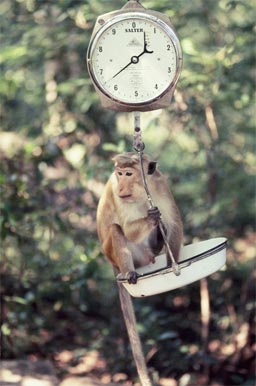Scientific Research
Aim
Our overall scientific aim is to increase knowledge about the biology and evolution of social behavior in primates, and by extension, in man. We conduct fundamental hypothesis-driven research and develop the principles of behavioral ecology and sociobiology as well as science based solutions to conservation problems.
Philosophy
From a biological point of view all living organisms are designed, by their genes, to perform one function only, namely: to pass the maximum number of copies of their inherited genes to future generations by way of surviving and reproducing. Genes encode body designs that serve to perpetuate the survival of its designers – the genes. Everything that constitutes an organism, its anatomy, physiology, biochemistry and behaviour has been honed by millions of years of natural selection ultimately to serve that purpose.
The diversity of life that we see today represents all of the different specialized body designs (species) that were most successful in surviving in a particular ecological niche, and past changes in their niches. The monkeys, that we study, are the end products of a constant adjustment, or weaning out of inferior ancestral body designs over eons of time. We are left today with designs (phenotypes) that were most successful in making a living in their own unique manner, in the tropical forest of Sri Lanka. By investigating the manner in which monkeys adapt to their social and external environment we gain an insight to the forces of natural selection in the evolution of behaviour.
Applying this reductionist philosophy to guide investigations of behaviour, we measure the effects of different behaviours, roles and strategies on the survival and reproductive costs and benefits (Darwinian fitness) of the actors. Behaviour occurs in an environmental context where ecological influences are prevalent. Thus, in measuring the effects of different behaviours on fitness, it is necessary also to measure the external parameters which affect fitness.
Empirical Base
To fulfill our aims, we investigate primates from the many different facets involved in their adaptations and the environmental context in which they evolved. For the empirical core to all our investigations we measure the effects of behavior and environment on survival and reproduction over individual lifetimes of long-lived primates. The research has been ongoing for nearly 45 years (at our site at Polonnaruwa) and involves over 4,000 individually known (living and dead) toque macaques (Macaca sinica). These individuals are systematically distinguished by their natural markings and many we have tattooed.
Out initial findings indicated that social behaviors influenced rates of death and reproduction (Darwinian fitness) in primates. To probe the relationship between vital statistics, behavior and environment more deeply, we expanded our investigations to include aspects of population genetics, paternity determination, parasitology, physiology and growth and development. We collaborate with several experts from different disciplines and international institutions. We diffuse our newly gained knowledge through publications and documentary films.
Aside from the toque macaques, we also monitor the behavioral and demographic fates of about 800 gray langurs (Semnopithecus priam) and purple-faced langur (Trachypithecus vetulus) and a handful of slender lorises (Loris lydekkerianus). These four primate species co-exist, sharing the same forest habitat at our study site, and they have all been investigated over the past 50 years for varying periods by different naturalists.
Relevance
Although we focus on primates, the principles and biological phenomena addressed by our studies have a much broader phylogenetic relevance among vertebrates, especially mammals. This includes the principles, processes and factors that govern animal population viability, genetic diversity, social behavior and organization, ecology and issues of health. Some of our research had established knowledge necessary for adaptive management and conservation.
Acquiring Knowledge
Questions of the adaptive nature of behavior are of interest to evolutionary considerations. But they must be preceded by an understanding of the structure and proximate function of behavior in a social and environmental context. They are of interest in their own right. Wild primates have complex behaviors. We have developed a systematic approach to understanding “what is going on”.
At the most basic level we have draw up an inventory, or a descriptive list of the entire behavioural repertoire (formally known as ethogram). Given an inventory of the structure of behaviours. we next ask about their functions. By definition, social behaviour, or communication, occurs when the action of one monkey changes that of another. What is the effect of a particular action (or gesture) on another monkey; what motives or information is being conveyed with the many different gestures, postures and sounds that monkeys exhibit? In short, how do monkeys manipulate one another, and why?
Other questions relate to the manifestations of complex behaviours such as the formation of aggressive coalitions or alliances with relations or “friends”. Do monkeys care for orphans and, if so, who does the care-giving, an aunt, the father (if known) or is it some unrelated lonely monkey? The distinction is important for considerations of the role of kinship in social living. The list of questions is extensive. Investigations of some behaviours, such as all those involving fathers, requires that we first identify the father by collecting DNA from the young, their mothers and all of the males who might be their father. The true father is identified through paternity exclusion analyses of the DNA.
Ultimately, we are interested to unravel the effects of social manipulation on survival, growth and reproduction?
Current Research
The accumulated knowledge base for the primates at Polonnaruwa is extensive. Therefore, current research focuses narrowly on cutting edge issues, some of which are unique to this study. We also aim to complete analysis of available data and ready it for publication. Learn more

